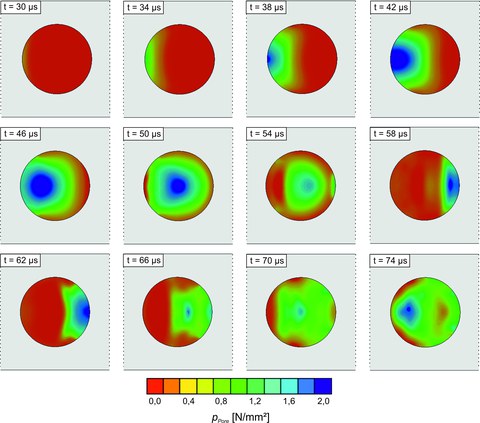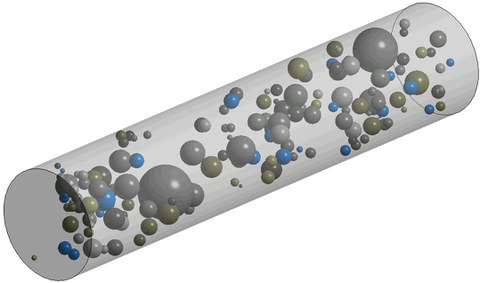Einfluss von Porenwasser auf die Wellenausbreitung in Beton
Inhaltsverzeichnis
Projektdaten
|
Titel | Title |
Das diesem Bericht zugrunde liegende Vorhaben wurde mit Mitteln des Bundesministeriums für Wirtschaft und Energie aufgrund eines Beschlusses des Deutschen Bundestages unter dem Förderkennzeichen 1501553 gefördert.
Bericht aus dem Jahrbuch 2020
SCHNELLER, FESTER, WASSER?

Druckverlauf in einer Wasserpore infolge einer Kompressionswelle
Beton weist unter schneller, dynamischer Beanspruchung eine höhere Festigkeit auf als unter langsamer, statischer. Dies wird als sogenannter Dehnrateneffekt bezeichnet und ist seit vielen Jahrzehnten Gegenstand der Forschung. Die möglichen Ursachen dieser Festigkeitssteigerung werden in verschiedenen Phänomenen gesehen, die meisten davon konnten jedoch bisher nur qualitativ nachgewiesen werden. Im Rahmen dieses Forschungsvorhabens wurde untersucht, inwieweit im Beton vorhandene Poren und darin befindliches Porenwasser das Ausbreitungsverhalten von Belastungswellen im Beton beeinflussen und ob darin eine weitere Ursache des Dehnrateneffektes gesehen werden kann.
In heterogenen Medien wie Beton kommt es bei der Ausbreitung von Belastungs-wellen aufgrund der unterschiedlichen Materialeigenschaften zu teilweisen Reflektionen und Übertragungen der Welle an den Grenzflächen der Einzelbestandteile. Infolge der unzähligen Reflektionen und Transmissionen im Inneren des Betons herrschen transiente,
also zeitabhängige, Spannungszustände und kein statisches Gleichgewicht. Im Projekt wurden numerische Simulationen mit unterschiedlich eingebrachten Modellporen und Störstellen durchgeführt. Dabei wurden Parameter, wie beispielsweise das Medium oder der Durchmesser der Poren, in verschiedenen Belastungsszenarien variiert. Speziell wurde der Frage nachgegangen, inwieweit vorhandenes Porenwasser im Vergleich
zur luftgefüllten Pore das Reflektions- und Transmissionsverhalten beeinflussen.
Es konnte gezeigt werden, dass messbare Festigkeitssteigerungen resultieren, insbesondere weil sich die Kerbspannungen am Porenrand unter dynamischer Belastung im Vergleich zu jenen unter statischer Belastung verringern. Infolge der Kerbspannungen wird die Festigkeit des Betons örtlich überschritten, es bilden sich Mikrorisse, welche als Beginn des Bruchvorganges aufgefasst werden können. Das Medium in der Pore – Luft oder Wasser – spielt dabei eine untergeordnete Rolle, sodass die veränderte Materialimpedanz infolge vorhandenen Porenwassers nicht als weitere Ursache des Dehnrateneffektes herangezogen werden kann.
Ergänzend zu den numerischen Untersuchungen wurden experimentelle Druckversuche an definiert wassergesättigten Betonproben durchgeführt, um den globalen Einfluss von Porenwasser auf die statische und dynamische Druckfestigkeit des Betons zu bestimmen. Hier zeigte sich, dass sowohl die statische als auch die dynamische Betondruckfestigkeit betragsmäßig in gleicher Weise mit steigendem Porenwassergehalt abfallen und demzufolge unabhängig von der Belastungsgeschwindigkeit sind.
Bericht aus dem Jahrbuch 2019
STÖRENFRIEDE IM BETON

Heterogenität des Betons
Zement, Zuschlag und Wasser – aufgrund seiner Zusammensetzung ist Beton das Paradebeispiel für Heterogenität. Der Zement dient als Bindemittel für die Zuschlagsstoffe, durch die Zugabe von Wasser werden die chemischen Abbindevorgänge eingeleitet. Nach der Erhärtung liegt dann ein festes, heterogenes Stoffgemisch vor – eine Art künstlich hergestelltes Gestein aus einer Zementmatrix, den Zuschlagsstoffen sowie Luft- und Wasserporen. Die Folge ist eine auf Mesoebene stark diskontinuierliche Steifigkeitsverteilung, unter einer Belastung resultieren Spannungsspitzen an den Grenzflächen der Bestandteile. Vergleichbar ist dies mit der Kerbspannungswirkung im Maschinenbau.
Ziel dieses Forschungsvorhabens ist es, den Einfluss dieser Störstellen – insbesondere der Wasserporen – auf die Ausbreitung von Druckwellen im Beton bei hohen Belastungsgeschwindigkeiten zu untersuchen.

Numerisches Modell einer Betonprobe mit unzähligen kugelförmigen Störstellen
In heterogenen Medien kommt es bei der Ausbreitung solcher Belastungswellen aufgrund der unterschiedlichen Materialeigenschaften zu teilweisen Reflektionen und teilweisen Übertragungen der Welle. Im Inneren herrschen transiente, also zeitabhängige, Spannungszustände und kein statisches Gleichgewicht. Es wird vermutet, dass infolge der Reflektionen und Transmissionen die mittlere Spannung im Inneren des heterogenen Betons geringer ist als die von außen aufgebrachte Spannung. Aus der Heterogenität kann daraus, in Kombination mit der schnellen Belastungsgeschwindigkeit, eine höhere gemessene Festigkeit des Betons folgen – eine mögliche Ursache des sogenannten Dehnrateneffektes.
Um qualitative und quantitative Aussagen dazu treffen zu können, werden numerische Simulationen mit verschieden eingebrachten Modellporen und Störstellen durchgeführt. Dabei werden Parameter, wie beispielsweise das Medium, der Durchmesser oder die Anzahl der Poren in unterschiedlichen Belastungsszenarien variiert. Ergänzend dazu werden Druckversuche an definiert wassergesättigten Betonproben durchgeführt, um den globalen Einfluss von Porenwasser auf die statische und dynamische Druckfestigkeit des Betons zu bestimmen. Hier zeigt sich, dass sowohl die statische als auch die dynamische Betondruckfestigkeit betragsmäßig in gleicherweise mit steigendem Sättigungsgrad abfällt.
Bericht aus dem Jahrbuch 2018
WASSER
Neben Zement und Zuschlag bildet Wasser einen Hauptbestandteil des Betons. So werden die Eigenschaften des Betons bei der Herstellung wesentlich durch das Verhältnis von Wasser und Zement, den sogenannten w/z-Wert, gesteuert.

Versagen der Betonproben: links: trockene Proben; rechts: wassergesättigte Proben
Nach der Erhärtung des Betons liegt das Wasser in unterschiedlichen Zuständen vor: zum einen in Form von chemisch und physikalisch gebundenem Wasser in den Calcium-Silikat-Hydrat-Phasen des Zementsteins, zum anderen verbleibt ein restlicher Teil als freies Wasser in der Porenstruktur des Betons. Die Umgebungsbedingungen, wie beispielweise Regenschauer, Luftfeuchtigkeit und Temperatur, steuern dabei die Wassersättigung der Poren im Beton.
Ziel dieses Forschungsvorhabens ist es, den Einfluss des freien Porenwassers auf die Ausbreitung von Druckwellen im Beton bei hohen Belastungsgeschwindigkeiten zu untersuchen. Dazu werden Betonprobekörper unterschiedlich lange wassergelagert, um definierte Sättigungsgrade, von trocken bis voll wassergesättigt, zu erzielen. Erste Ergebnisse zeigen, dass die Betondruckfestigkeit mit steigendem Wassersättigungsgrad abfällt. Dieses Phänomen konnte sowohl im statischen als auch im dynamischen Belastungsfall in gleicher Weise beobachtet werden. Die Mechanismen, welche zur Festigkeitsreduktion führen, scheinen demnach unabhängig von der Belastungsgeschwindigkeit zu sein.

Schädigung der Probe im dynamischen Split-Hopkinson-Bar-Versuch
Im Vergleich zu wassergesättigten Proben versagen die trockenen Betonproben explosionsartiger, mit einer erhöhten Riss- und Bruchstückanzahl. Es wird angenommen, dass das freie Porenwasser die innere Reibung und Verzahnung an den Rissoberflächen herabsetzt. Die Bruchflächen gleiten somit besser aneinander ab und mindern die Druckfestigkeit des Betons. An den Rissspitzen wirkt das Wasser als eine Art Keil und beschleunigt die Rissbildung. Durch die Verwendung unterschiedlich geformter Betonprobekörper konnte außerdem festgestellt werden, dass im Vergleich zu schräg verlaufenden Rissen bei parallel zur Belastungsrichtung verlaufenden Rissen ein höherer Festigkeitsabfall zu beobachten ist.
Das diesem Bericht zugrunde liegende Vorhaben wurde mit Mitteln des Bundesministeriums für Wirtschaft und Energie aufgrund eines Beschlusses des Deutschen Bundestages unter dem Förderkennzeichen 1501553 gefördert.
Bericht aus dem Jahrbuch 2017
WELLEN IM BETON

Mit Wasser gefüllter Schlauch im Split-Hopkinson-Bar
Flugzeuganprall, Erdbeben und Explosionen – solche außergewöhnlichen Beanspruchungen sind entscheidend für die Bemessung und Konstruktion von Gebäuden der kritischen Infrastruktur, wie beispielsweise Kraftwerke oder Flughäfen. Um die Sicherheit dieser Bauwerke zu gewährleisten und beurteilen zu können, ist das Verständnis des Material- und Schädigungsverhaltens von Beton unter schneller, dynamischer Einwirkung von entscheidender Bedeutung.
Beton weist unter dynamischer Beanspruchung höhere Festigkeiten als im quasi-statischen Fall auf. Dieses Phänomen ist seit über 100 Jahren bekannt und wird als sogenannter Dehnrateneffekt bezeichnet. Neben Trägheitseffekten aufgrund der geschwindigkeitsabhängigen Wachstumsrate der Mikrorisse gilt das Porenwasser als weitere Ursache für diese Festigkeitssteigerung. Das viskose Verhalten des freien Wassers zwischen den Rissoberflächen erzeugt Kapillarkräfte, welche dem Risswachstum entgegenwirken. Zudem beeinflussen die Poren und deren Wassergehalt maßgeblich die Ausbreitung der Belastungswelle.
Zur Beschreibung der Wellenausbreitung an diesen Störstellen sollen künstliche Modellporen in Betonproben eingebracht und im Split-Hopkinson-Bar dynamisch belastet werden. Anzahl, Größe, Lage und Wassergehalt der künstlich erzeugten Poren werden dabei variiert. Um die Einflüsse anderer Inhomogenitäten, wie Zuschlagkörner und Luftporen, zu reduzieren, wird ein sehr feinkörniger, gut verdichteter Beton verwendet.
Darüber hinaus ist besonderes Augenmerk auf die Messtechnik und speziell deren Anordnung zu legen. Da die Belastungswelle den Probekörper innerhalb weniger Mikrosekunden durchläuft, ist eine hohe Abtastrate der Dehnmessstreifen erforderlich. Außerdem kommt es an den Störstellen zu einer nur teilweisen Übertragung, zu Reflexion und Überlagerung der eingetragenen Welle. Die Position der Dehnungsmesser bestimmt somit, welcher Anteil der Welle gemessen wird. In Kombination mit numerischer Simulation werden die experimentell gewonnenen Ergebnisse verifiziert, um Erkenntnisse über den Einfluss von wassergefüllten Poren auf das Verhalten von Beton unter Stoßbelastung zu erlangen.
Das diesem Bericht zugrunde liegende Vorhaben wurde mit Mitteln des Bundesminis-teriums für Wirtschaft und Energie aufgrund eines Beschlusses des Deutschen Bundestages unter dem Förderkennzeichen 1501553 gefördert.
